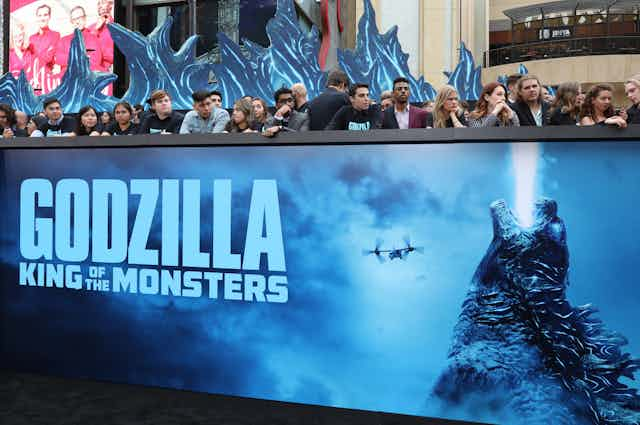A new Godzilla mega-movie is rampaging across the globe, its giant green monster stomping and screeching upon the silver screen.
It hits theatres this week.
Since its first appearance in 1954 as a mutated dinosaur-like monster, Godzilla has often spread an environmental message to the public – though the exact make-up of the message has evolved over time.
Once synonymous with the monstrous nature of nuclear disaster, the new movie seems to ditch Godzilla’s old anti-nuclear stance to focus on environmental concerns more presently in the public mind, like climate change and mass extinction. The film’s cast and producers have noted and endorsed this environmental theme.
Godzilla now
The 2019 Godzilla outing sets up the titular monster as an ancient natural being, evolved a long time ago when the Earth was far more radioactive. The monster is presented as a guardian of nature seeking to bring balance to a world messed up by human activity.
In this latest Godzilla, nuclear energy is natural and nuclear bombs are benign since the monster uses atomic power to energise himself in his battles against a suite of enemy monsters. The Godzilla monster also enters into an alliance with the United States military to vanquish their common enemies and to claim the throne of “King of the Monsters”.
The Godzilla of 2019 will seem like pretty shallow “eco-cinema” to most environmentalists. Yet deeper eco-films like An Inconvenient Truth or Before the Flood might only be viewed by those already swayed by environmental arguments. Godzilla has potential “broad spectrum” advantage, seducing a much wider audience into sitting in on a film with an environmental back story.
If we’re feeling charitable, we can conjecture that some proportion of this wider audience might be pushed a little more toward caring about the present-day environmental crisis. Alas, though, a critical reflection upon 2019’s Godzilla would resist the idea that “nukes” or “the military” can serve as saviours of the Earth.
The most recent Godzilla producers have enjoyed a good working relationship with the US military in order to credibly represent the army and navy on screen. Such relationships assure filmmakers access to spectacular military hardware – tanks and warships, for instance. The US Army seems very happy with the results but, given the environmental impact of military activities, the producers might have done better to work with conservationists as they strove to envision Godzilla as an ecological being.
Godzilla in the past
Godzilla in fiction is some 65 million years old. In fact, he’s a mere 65.
The very first Godzilla movie, or Gojira in Japanese, was made in Japan in 1954; the monster being accidentally exhumed by an atomic bomb test in the Pacific Ocean. The monster then came ashore to destroy the capital Tokyo.
The message of the first Godzilla was clear: nuclear bombs and nuclear pollution are monstrous; messing about with them will invite catastrophe upon both nature and humanity. Such a theme resonated strongly in a nation that had recently lived through the devastating Hiroshima and Nagasaki nuclear attacks on Japan.
However, if Godzilla’s primary goal was to fend off dangerous nuclear development, it failed. Japan soon embarked upon a massive nuclear energy program.
As well as being ineffectual, Godzilla might also be regarded as unoriginal. Many science-fiction fans acknowledge that 1954’s Godzilla was inspired by a 1953 Hollywood “creature feature”, The Beast from 20,000 Fathoms, whose gigantic dinosaur “star” was also born from a nuclear test blast.
The writers of The Beast from 20,000 Fathoms managed to shine a light on their own militarised society, the US, outlining the horrendous power of homemade mega-weapons. However, the 1954 Godzilla writers did no such thing; they blamed Godzilla’s monstrous birth not on any homemade Japanese military endeavour but upon US nuclear bomb tests in the Pacific.
By doing this, the original Godzilla avoids investigating Japan’s own mid-century fixations with military power and chooses instead to apportion the majority of the moral blame for the second world war’s “horrific violence” upon the US and its inhumane nuclear bombs. This anti-American attitude had to be edited out of the 1954 Godzilla film before hitting US cinemas.
The evolution of Godzilla
Since the 1954 movie, more than 30 Godzilla features have been produced.
In the 1960s and 1970s, Godzilla became memorably kitschy. There’s nothing so camp as two actors dressed up in rubber whilst trading blows as grinning monsters. Some film critics deride these ’60s and ’70s versions as artless and childish, but others have noted the value and charm of showcasing beloved monsters as eccentric anti-heroes whose battles could be imaginatively emulated by excited schoolchildren.
As light-hearted as they were, the 1960s and 1970s Godzilla movies often managed to spread an environmental message by resurrecting the anti-nuclear theme or by referencing other kinds of pollution.
For example, the 1971 movie Godzilla Vs the Smog Monster flags up the horrific character of marine pollutants and urban smog.
In the 2014 Godzilla movie, the anti-nuclear message seems for a moment to reappear. The opening act portrays a nuclear plant suffering a Fukushima-type meltdown and an abandoned city that resembles a Fukushima ghost town in Japan.
However, we soon learn the disaster is caused by a gigantic radiation-hungry mutant and not by safety lapses or general technological hubris.
All in all, Godzilla has often been praised by critics and fans as reflecting public concerns about environmental disaster. Yet the environmental messages that many Godzilla episodes convey is often so encumbered with competing narratives, and also by the need for fantastic spectacle, that the eco-message is confused or diminished.


